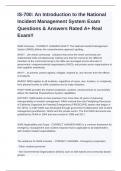IS-700: An Introduction to the National
Incident Management System Exam
Questions & Answers Rated A+ Real
Exam!!
NIMS Overview - CORRECT ANSWER-WHAT? The National Incident Management
System (NIMS) defines the comprehensive approach guiding...
WHO? ...the whole community - solutions that serve the entire community are
implemented while simultaneously making sure that the resources the different
members of the community bring to the table are leveraged across all levels of
government, nongovernmental organizations (NGO), and private sector organizations to
work together seamlessly
WHY? ...to prevent, protect against, mitigate, respond to, and recover from the effects
of incidents.
WHEN? NIMS applies to all incidents, regardless of cause, size, location, or complexity,
from planned events to traffic accidents and to major disasters.
HOW? NIMS provides the shared vocabulary, systems, and processes to successfully
deliver the National Preparedness System capabilities.
HISTORY: NIMS builds on best practices from more than 40 years of improving
interoperability in incident management. NIMS evolved from the Firefighting Resources
of California Organized for Potential Emergencies (FIRESCOPE) system that began in
the 1970s. In 1982 NIMS was developed through government collaboration with incident
management practitioners, NGOs and the private sector. The first NIMS document was
published by FEMA in 2004 and was revised in 2008 and 2017.
NIMS Applicability and Scope - CORRECT ANSWER-NIMS is a common framework for
emergency management and incident response that is applicable to all stakeholders
with incident related responsibilities.
The audience for NIMS includes: - CORRECT ANSWER-- Emergency responders
- Other incident personnel
- Non-Governmental Organizations (NGOs) such as faith-based and community-based
groups
,- The private sector
- Elected and appointed officials
- People with disabilities or access and functional needs
The scope of NIMS includes: - CORRECT ANSWER-- All incidents, regardless of size,
complexity, or scope
- Planned events such as sporting events
NIMS is: - CORRECT ANSWER-- A comprehensive, nationwide, systematic approach
to incident management, including the command and coordination of incidents, resource
management, and information management
- A set of concepts and principles for all threats, hazards, and events across all mission
areas (Prevention, Protection, Mitigation, Response, Recovery)
- Scalable, flexible, and adaptable; used for all incidents, from day-to-day to large-scale
- Standard resource management procedures that enable coordination among different
jurisdictions or organizations
- Essential principles for communications and information management
NIMS is not: - CORRECT ANSWER-- Only the Incident Command System
- Only applicable to certain emergency/incident response personnel
- A static system
- A response plan
- Used only during large-scale incidents
- A resource ordering system
- A communications plan
NIMS Guiding Principles - CORRECT ANSWER-Incident management is the
application of resources by organizations to plan for, respond to, and recover from an
incident.
Priorities for incident management in planning, response, and recovery efforts include
savings lives, stabilizing the incident, and protecting property and the environment.
,To achieve these priorities, incident management personnel use NIMS components in
accordance with three NIMS guiding principles:
- Flexibility
- Standardization
- Unity of Effort
NIMS Guiding Principle: Flexibility - CORRECT ANSWER-Allows NIMS to be scalable
from routine, local incidents through those requiring interstate mutual aid up to those
requiring Federal assistance.
Flexibility enables NIMS to be applicable to incidents that vary widely in terms of
hazard, geography, demographics, climate, cultural, and organizational authorities.
NIMS components are adaptable to any type of event or incident.
NIMS Guiding Principle: Standardization - CORRECT ANSWER-Supports
interoperability among multiple organizations in incident response.
- Standard organizational structures
- Standard Practices
- Common Terminology
Parts of Standardization (3) - CORRECT ANSWER-Standard Organizational Structures:
Improve integration and connectivity among organizations
Standard Practices: Allow incident personnel and organizations to work together
effectively.
Common Terminology: Enables effective communication.
, NIMS Guiding Principle: Unity of Effort - CORRECT ANSWER-Coordinating activities
among various organizational representatives to achieve common objectives. Unity of
effort enables organizations with jurisdictional authority or functional responsibilities to
support each other while allowing each participating agency to maintain its own
authority and accountability.
NIMS Framework - Major Components - CORRECT ANSWER-Jurisdictions and
organizations involved in the management of incidents vary in their authorities,
management structures, communication capabilities and protocols, and many other
factors. The major Components of NIMS provide a common framework to integrate
these diverse capabilities and achieve common goals.
- Resource Management
- Command and Coordination
- Communications and Information Management
The application of all there components is vital to successful NIMS implementation.
Major Components of NIMS (3) - CORRECT ANSWER-- Resource Management
- Command and Coordination
- Communications and Information Management
Resource Management preparedness involves four key activities: - CORRECT
ANSWER-- Identifying and typing resources
- Qualifying, certifying, and credentialing personnel
- Planning for resources
- Acquiring, storing, and inventorying resources
Typing Resources - CORRECT ANSWER-- Defines and categorizes incident resources
by capability.
- Establishes common definitions for capabilities of personnel, equipment, teams,
supplies, and facilities.





